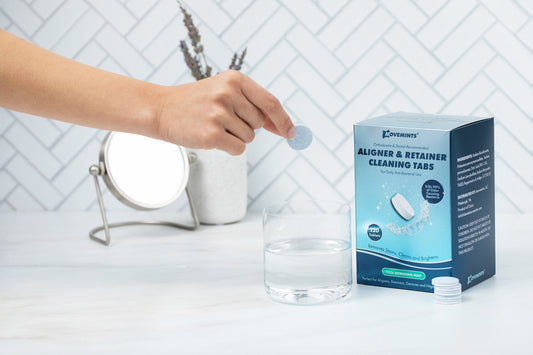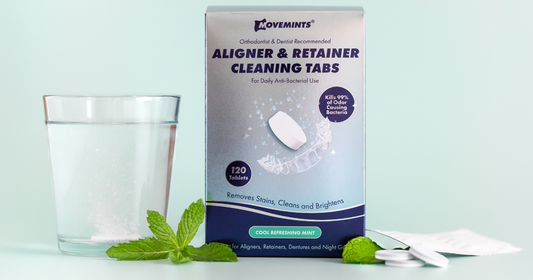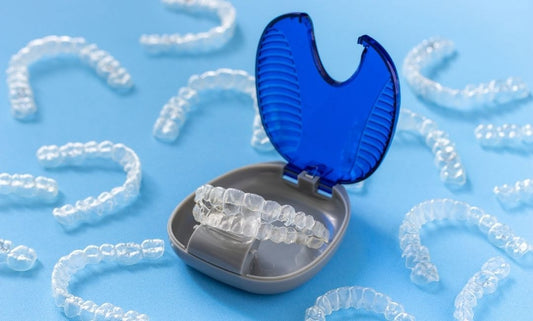Is Your Invisalign Not Tracking? Try This
Written by Dr. Dave Pechersky, practicing orthodontist and inventor of Movemints
If your Invisalign trays suddenly feel loose or aren’t sitting flush against your teeth, don’t worry. Tracking issues happen to a lot of patients, and they’re usually easy to fix. As an orthodontist, I’ve seen this many times, which is why I created Movemints Aligner Mints to help patients seat their trays comfortably, stay consistent with wear time, and keep their breath fresh along the way.
 What Invisalign Tracking Means
What Invisalign Tracking Means
Tracking refers to how closely your aligners fit the shape of your teeth. When your trays are tracking properly, they sit tight and flush against every surface. If you notice gaps or looseness, your aligners probably aren’t tracking.
Here’s what a good fit looks like:
- Snug fit: your trays feel stable and secure
- No gaps: the plastic sits evenly against your teeth
- Attachments engaged: if you have attachments, the trays click into place
A little tightness is normal, especially with a new set. That’s a sign your teeth are moving. But if your trays still feel loose or uneven after a few days, it’s time to troubleshoot.
Why Invisalign Might Stop Tracking

1. You’re Not Wearing Your Trays Enough
Aligners only work when they’re in your mouth. Aim for at least 22 hours a day. Skipping hours can let your teeth shift, making your next trays harder to seat. Try a timer app or keep a pack of Movemints nearby to remind you to put them back in.
2. You Switched Too Soon
Each aligner is designed to move your teeth a specific amount. If you switch before your teeth are ready, the new tray won’t fit right. Always check with your orthodontist before moving ahead early.
3. Your Trays Are Warped or Damaged
Hot water, rough removal, or leaving aligners in a warm car can cause warping. Even tiny bends or cracks can affect the fit. If your trays look uneven or feel off, ask your orthodontist about a replacement.
4. Some Teeth Move Slower Than Others
Everyone’s teeth move at different speeds. Sometimes they collide or crowd each other, which throws off tracking. Your orthodontist might recommend a small polish between teeth (called IPR) to make space and help everything line up again.
How to Fix Invisalign Tracking Problems
1. Do Chewing Exercises with Movemints
Chewing helps your trays seat all the way down. Instead of foam chewies, use Movemints Clear Aligner Mints, the edible, aligner-safe alternative I developed for my patients.
They’re sugar-free, made with xylitol to help with dry mouth, and shaped with a patented groove that helps guide your trays into place. Pop one in, bite down gently, and let it dissolve while your aligners settle.
2. Stick to the 22-Hour Rule
Consistency is key. Take your trays out to eat, brush, or clean them, then put them right back in. The more you wear them, the smoother your treatment will go.
3. Ease Soreness the Right Way
Some soreness means your aligners are doing their job. Sip cold water, eat soft foods, or use a cold compress on your cheeks. Avoid hot water or heat, which can warp your trays.
4. Ask Your Orthodontist About Wearing the Previous Tray
If a new tray still won’t fit after a few days of good wear time and chewing exercises, your orthodontist might recommend wearing the previous set a bit longer. This gives your teeth time to catch up before moving forward.
Final Thoughts
Tracking problems are a normal part of clear aligner treatment, and they don’t mean your treatment isn’t working. Stay consistent, keep your trays clean, and use Movemints to help seat them properly.
If you’re still having trouble after a few days, check in with your orthodontist. A small adjustment can get you right back on track.





